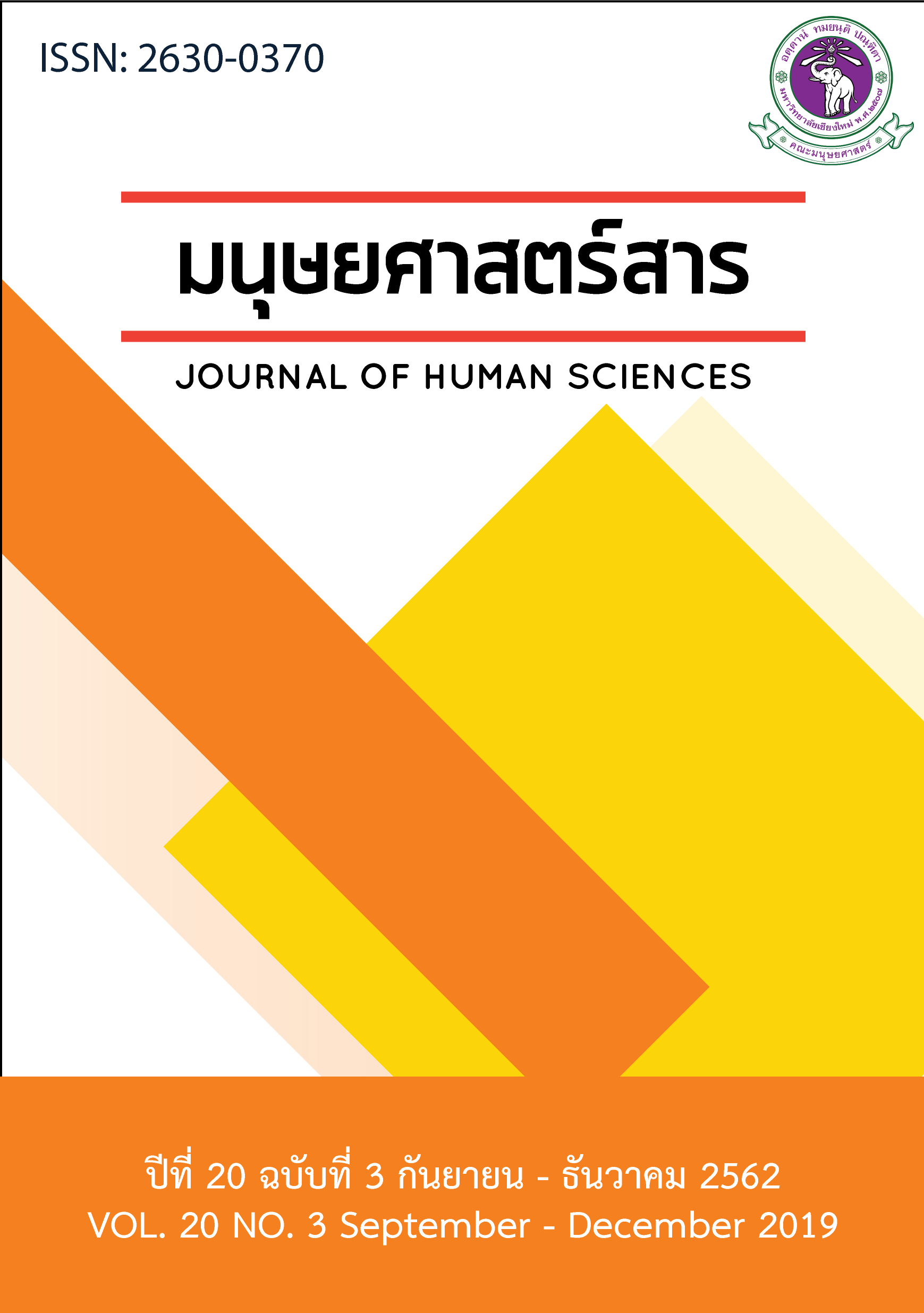การศึกษาทัศนคติต่อเหตุการณ์เยาวชนติดถ้ำโดยใช้ภาษาศาสตร์ คลังข้อมูลเป็นฐาน
Main Article Content
บทคัดย่อ
เหตุการณ์เกี่ยวเยาวชนติดถ้ำเมื่อเร็วๆ นี้เป็นหนึ่งในเหตุการณ์ที่ผู้คนรู้จักกันอย่างดี และไม่ใช่แค่เหตุการณ์เพียงอย่างเดียวที่ทำให้ผู้คนรู้จักเหตุการณ์นี้ แต่ยังเป็นเพราะความสำเร็จในการช่วยเหลือเยาวชนอันเนื่องมาจากความร่วมมือ ร่วมใจของผู้คนจากทั่วโลกอีกด้วย วัตถุประสงค์ของงานวิจัยชิ้นนี้คือ เพื่อวิเคราะห์ทัศนคติของผู้ใช้งานทวิตเตอร์ผ่านภาษาที่ใช้ในการแสดงความคิดเห็น คลังข้อมูลภาษาประกอบด้วยคำจำนวน 16,621 คำซึ่งเก็บรวบรวมจากภาษาที่ใช้ในการแสดงความคิดเห็นในข่าวจากบัญชีทางการของสำนักข่าวบีบีซี (BBC) และซีเอ็นเอ็น (CNN) ในทวิตเตอร์และวิเคราะห์โดยพิจารณาจากความถี่ของคำ การวิเคราะห์คำสำคัญ การกระจายตัว โปรแกรม Linguistic Inquiry and Word Count (LIWC) และ Semantic Tagger ผลการวิจัยแสดงให้เห็นว่าวลีที่ผู้ใช้ทวิตเตอร์กล่าวถึงมากที่สุดคือ “the boys” นอกจากนี้ เมื่อพิจารณากราฟการกระจายตัวพบว่าวลี “the boys” นั้นกระจายตัวอยู่ทั่วคลังข้อมูลภาษามากที่สุดเช่นกัน แสดงให้เห็นว่า “the boys” ซึ่งหมายถึงเยาวชนติดถ้ำเป็นประเด็นที่ผู้ใช้ทวิตเตอร์เป็นห่วงและให้ความสนใจมากที่สุด นอกจากนี้ ผลการวิจัยที่สอดคล้องกันของ LIWC และ Semantic Tagger แสดงให้เห็นว่า ผู้ใช้ทวิตเตอร์มีทัศนคติด้านบวกต่อเหตุการณ์ครั้งนี้ และสรุปได้ว่า ไม่ว่าจะเกิดเหตุการณ์ใดขึ้น ผู้คนจากทั่วโลกยังคงสนับสนุนช่วยเหลือกันและกันเสมอ
Article Details
เอกสารอ้างอิง
Allport, G. (1935). Attitudes. In C. Murchison (Ed.), A Handbook of Social Psychology (Vol. 2, pp. 798–844). Worcester, MA: Clark University Press.
Anthony, L. (2014). AntWordProfiler Version 1.4.1 (Software). Tokyo, Japan: Waseda University.
Anthony, L. (2018). AntConc Version 3.5.7 (Software). Tokyo, Japan: Waseda University.
Antonak, R., & Livneh, H. (1995). Direct and Indirect Methods to Measure Attitudes toward Persons with Disabilities, with an Exegesis of the Error-Choice Test Method. Rehabilitation Psychology, 40(1). 3-24.
Baker, C. (2006). Introduction to Language Policy: Theory and Method. In T. Ricento (Ed.), An Introduction to Language Policy: Theory and Method. (pp. 210–228). Oxford, UK: Blackwell.
Clement, J. (2019). Twitter: Number of Monthly Active Users 2010-2019. Retrieved from https://www.statista.com/statistics/282087/number-of-monthly-active-twitter-users/
Coxhead, A. (2000). A New Academic Word List. TESOL Quarterly, 34(2). 213-238.
Drasovean, A., & Tagg, C. (2015). Evaluative Language and its Solidarity-Building Role on TED.com: An Appraisal and Corpus Analysis. Language@Internet, 12(1).
Eagly, A., & Chaiken, S. (1993). The Psychology of Attitudes. New York: Harcourt Brace Jovanovich.
Gardner, R. (2002). Social Psychological Perspectives on Second Language Acquisition. In R. Kaplan (Ed.), The Oxford Handbook of Applied Linguistics (pp. 160–169). New York: Oxford University Press.
Garrett, P. (2010). Attitudes to Language. Cambridge, UK: Cambridge University Press.
Graham, D. (2014). Key-BNC (Software). Retrieved from http://crs2.kmutt.ac.th/Key-BNC/
Gries, S. (2010). Useful Corpus-linguistics Statistics. In A. Sánchez & M. Almela (Eds.), A Mosaic of Corpus Linguistics: Selected Approaches (pp. 269–291). Frankfurt am Main: Peter Lang.
Herring, S. (2008). Virtual Community. In L. M. Given (Ed.), Encyclopedia of Qualitative Research Methods (pp. 920-921). London: Sage.
Herring, S., Stein, D., & Virtanen, T. (2013). Pragmatics of Computer-Mediated Communication. Berlin, Germany: De Gruyter Mouton.
Ivković, D. (2013). The Eurovision Song Contest on YouTube: A Corpus-based Analysis of Language Attitudes. Language@Internet, 10(1).
Kennedy, G. (1998). An Introduction to Corpus Linguistics. London, New York: Longman.
Koppel, M., & Schler, J. (2006). The Importance of Neutral Examples for Learning Sentiment. Computational Intelligence, 22(2), pp. 100–109.
Lindquist, H. (2009). Corpus Linguistics and the Description of English. Edinburgh: Edinburgh University Press.
Pang, B., Lee, L., & Vaithyanathan, S. (2002). Thumbs up? Sentiment Classification using Machine Learning Techniques. In Proceedings of the Conference on Empirical Methods in Natural Language Processing (EMNLP). pp. 79–86.
Pang, B., & Lee, L. (2004). A Sentimental Education: Sentiment Analysis Using Subjectivity Summarization Based on Minimum Cuts. In Proceedings of the Association for Computational Linguistics (ACL). pp. 271–278.
Pang, B., & Lee, L. (2005). Seeing stars: Exploiting class relationships for sentiment categorization with respect to rating scales. In Proceedings of the Association for Computational Linguistics (ACL). pp. 115–124.
Pennebaker, J., Booth, R., & Francis, M. (2007). Linguistic Inquiry and Word Count: LIWC [Computer software]. Austin, TX: LIWC.net.
Rayson, P., Archer, D., Piao, S., & McEnery, T. (2004). The UCREL semantic analysis system. In proceedings of the workshop on Beyond Named Entity Recognition Semantic labelling for NLP tasks in association with 4th International Conference on Language Resources and Evaluation (LREC 2004), 25th May 2004, Lisbon, Portugal, pp. 7-12.
Ryan, E., Giles, H., & Hewstone, M. (1988). The Measurement of Language Attitudes. In U. Ammon, N. Dittmar, & K. Mattheier (Eds.), Sociolinguistics: An International Handbook of the Science of Language and Society (pp. 1068–1082). Berlin: Walter de Gruyter.
Stubbs, M. (1996). Text and corpus analysis. Oxford: Blackwell.
Tausczik, Y., & Pennebaker, W. (2010). The Psychological Meaning of Words: LIWC and Computerized Text Analysis Methods. Journal of Language and Social Psychology, 29(1), 24-54.
Tsou, A., Thelwall, M. Mongeon, P., & Sugimoto, C. (2014). A Community of Curious Souls: An Analysis of Commenting Behavior on TED Talks Videos. PloS ONE, 9(4).
West, M. (1953). A General Service List of English Words. London: Longman.


